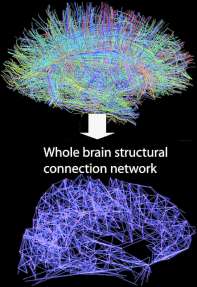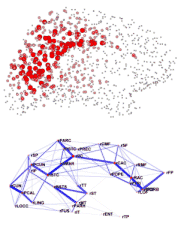 A fantastic new study which looked at the ‘connectedness’ of the human brain has identified which aspects of the underlying network are the most important routes of communication.
A fantastic new study which looked at the ‘connectedness’ of the human brain has identified which aspects of the underlying network are the most important routes of communication.
The research was led by neuroscientist Patric Hagmann and combines brain imaging with network mathematics to not only visualise the brain’s network but also to understand which are the most important hubs and connections.
The study used diffusion spectrum imaging or DSI to map out the white matter wiring of the brain in five healthy individuals.
It’s a type of diffusion MRI that identifies water molecules and tracks how they move. In a glass of water, water molecules will move randomly, but when trapped inside nerve fibres, they move along the length of the fibre, allowing maps to be created from the average paths of the moving molecules.
The researchers then took the maps of fibres, as illustrated by the top image, divided the brain up into sections, and created a simplified network map, shown in the bottom image, which allowed them to mathematically test how connected the different areas were.
They used network theory, more typically used in social network analysis, which allows mathematical measures of network properties.
The researchers calculated which areas were the most connected to the rest of the network in terms of connections going directly in and out of the area, but also which areas were the most strategically important ‘hubs’.
 This meant the researchers could identify areas of the cortex that are the most highly connected and highly important, forming a structural core of the human brain.
This meant the researchers could identify areas of the cortex that are the most highly connected and highly important, forming a structural core of the human brain.
You can see two of the maps on the right. The one in red illustrates which brain areas are the most highly connected. You can see it’s the area at the top and back of the brain. As you can see better on the original image, its very centrally located, like a neural mohawk.
The image in blue on the right shows the network ‘backbone’, the information highways of the brain.
What’s perhaps most interesting it that the most connected brain areas are many of those which are more active when we’re at rest, compared to when we’re engaged in a mental task that requires concentration and effort.
This has been dubbed the ‘default network’ in the scientific literature, and, rather annoyingly, the ‘daydreaming network’ by the popular press.
It’s not entirely clear what the network is for, with some studies directly linked it to ‘stimulus independent thought’ (yes, daydreaming), while others more explicitly define it as internally focused, rather than externally focused thought and cognition.
Unfortunately, most cognitive neuroscience experiments work by measuring the effect of tasks on brain function, so a brain network which seems to be switched off by any sort of task is quite hard to study. A recent study found that even the noise of the brain scanner affects it.
Link to PLoS Biology article on brain connectivity.
Link to write-up from The New York Times.
Link to write-up from Neurophilosophy.
Link to write-up from Science News.